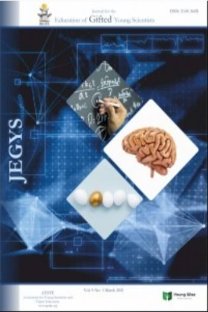A Combined HOTS-Based Assessment/STEM Learning Model to Improve Secondary Students’ Thinking Skills: A Development and Evaluation Study
An integrated STEM education has been used for a long time to improve Higher Order Thinking Skills (HOTS) of students. This skills covered the capability to analyze, evaluate, and create which can be enhanced by implementing a right learning model, materials, and assessment. This study aims to develop and evaluate a combined HOTS-based assessment/STEM learning model to improve the students’ thinking skills. A proposed model was designed by following the seven steps of Borg & Gall research and development. The impact of this model was evaluated by analyzing the average gain of pretest-posttest and Tukey signification difference test compared to a conventional STEM model. The result showed a significant difference between two treatments (t-value = 4.63; p < 0.001). It also conform a better improvements of students’ thinking skills by our model based on the analysis of gain score distribution. Keywords: STEM learning model, HOTS-based assessment, research and development, secondary students
___
- Anderson, O. W., & Krathwohl, D. R. (2001). A Taxonomy for Learning Teaching and Assessing. Newyork: Addison Wesley Longman.
- Barnett, J. E., & Francis, A. L. (2012). Using Higher Order Thinking Questions to Foster Critical Thinking: A Classroom Study. Educational Psychology, 32(2), 201–211. https://doi.org/10.1080/01443410.2011.638619
- Becker, K. H., & Park, K. (2011). Integrative Approaches among Science, Technology, Engineering, and Mathematics (STEM) Subjects on Students Learning: A Meta Analysis. Journal of STEM Education: Innovations and Research, 12(5).
- Brown, R., Brown, J., Reardon, K., & Merrill, C. (2011). Understanding STEM: Current Perceptions. Technology and Engineering Teacher, 70(6), 5–9.
- Guilford, J. . (1956). Fundamental Statistic in Psychology and Education.3rd Ed. New York: McGraw-Hill Book Company, Inc.
- Guo, S., Freeman, S., Lawhorn, J., & Zheng, A. (2008). 1018 Free Access to Landsat Imagery Teach by the Book Science Education : Science, 320(5879), 1011–1012. https://doi.org/10.1126/science.320.5879.1011a
- Hake, R. R. (2001). Lesson from the Physics-Education Reform Effort. Conservation Ecology, 1–61.
- Kaya, D., & Aydın, H. (2016). Elementary Mathematics Teachers’ Perceptions and Lived Experiences on Mathematical Communication. Eurasia Journal of Mathematics, Science & Technology Education, 12(6), 1619–1629. https://doi.org/10.12973/eurasia.2014.1203a
- Krathwohl, D. R. (2002). A Revision of Bloom’s Taxonomy: An Overview. Theory Into Practice, 41(4).
- Kristianingsih, D. D., Wijayati, N., & Sudarmin. (2016). Pengembangan LKS Fisika Bermuatan Generik Sains untuk Meningkatkan Higher Order Thinking (HOTS) Siswa. Journal of Innovative Science Education, 5(1), 73–82.
- McNeill, M., Gosper, M., & Xu, J. (2012). Assessment Choices to Target Higher Order Learning Outcomes: the Power of Academic Empowerment. Research in Learning Technology, 20(0). https://doi.org/10.3402/rlt.v20i0.17595
- Morrison, J. (2006). TIES STEM Education Monograph Series: Attributes of STEM Education. Baltimorc: MD: TIES.
- Narayanan, S., & Adithan, M. (2015). Analysis Of Question Papers In Engineering Courses With Respect To Hots (Higher Order Thinking Skills). American Journal of Engineering Education (AJEE), 6(1), 1. https://doi.org/10.19030/ajee.v6i1.9247
- Nitko, A. J., & Brookhart, S. M. (2011). Educational Assessment of Student. Boston: Pearson Education. OECD. (2015). Pisa 2015.
- Sanders, M. (2009). STEM, STEM Education, STEMmania. The Technology Teacher, 68(4).
- Sanders, M., Kwon, H., Park, K., & Lee, H. (2011). Integrative STEM (Science, Technology, Engineering, and Mathematics) Education: Contemporary Trend and Issues. Secondary Education, 53(3).
- Sastrawati, E., Rusdi, M., & Syamsurizal. (2011). Problem-Based Learning, Strategi Metakognisi dan Keterampilan Berpikir Tingkat Tinggi Siswa. Tekno-Pedagogi, 1(2), 1–14.
- Stohlmann, M., Moore, T. J., & Roehrig, G. H. (2012). Considerations for Teaching Integrated STEM Education. Journal of Pre-College Engineering Education Research, 2(1), 28–34. https://doi.org/10.5703/1288284314653
- Subramaniam, M. M., Ahn, J., Fleischmann, K. R., & Druin, A. (2012). Reimagining the Role of School Libraries in STEM Education: Creating Hybrid Spaces for Exploration. The Library Quarterly, 82(2), 161–182. https://doi.org/10.1086/664578
- Syafa’ah, H. K., & Handayani, L. (2015). Pengembangan Metacognitive Self-Assesment untuk Mengukur Keterampilan Berpikir Evaluasi dalam Membaca Teks Sains Berbahasa Inggris. UPEJ Unnes Physics Education Journal, 4(1), 43–48. https://doi.org/10.15294/UPEJ.V4I1.4742
- Van de Walle, J. A. (2007). Elementary and Middle School Mathematics: Teaching Developmentally, (6th ed.). Boston: Pearson Education, Inc.
- Zheng, A. Y., Lawhorn, J. K., Lumley, T., & Freeman, S. (2008, January). ASSESSMENT: Application of Bloom’s Taxonomy Debunks the “MCAT Myth.” Science, 319(5862), 414–415. https://doi.org/10.1126/science.1147852
- Başlangıç: 2013
- Yayıncı: Genç Bilge Yayıncılık
Sayıdaki Diğer Makaleler
Syamsul HUDA, Rizqi Amaliyakh SHOLİKHAKH, Nuraini Sri BİNA, Fitria LESTARİ, Beni HABİBİ, Putut SUHARSO
Wattana SADUAK, Pakkapong POUNGSUK, Ratchadakorn PHONPAKDEE, Sataporn DEEYING
Van Bien Nguyen, Xayparseut VYLAYCHİT, Anh Thuan NGUYEN
Zuhkhriyan ZAKARİA, Punaji SETYOSARİ, Sulton SULTON, Dedi KUSWANDİ
Beatrix Elvi DASİLVA, Tiara Kusuma ARDİYATİ, Suparno SUPARNO, Sukardiyono SUKARDİYONO, Erlin EVELİNE, Tri UTAMİ, Zera Nadiah FERTY
Hadarah HADARAH, Rapiah TULHIKMAH
Undang ROSİDİN, Agus SUYANTA, Abdurrahman ABDURRAHMAN
Syafrizal SYAFRİZAL, Masrupi MASRUPİ, İstiqomatul MAULUDAH
Umi Anugerah IZZATI, Bachtiar Syaiful BACHRI, M. SAHİD, Dian Eka INDRİANİ
